|
This image was created at the Anhinga Trail, Everglades National Park with the tripod-mounted Canon EF 600mm f/4L IS II USM lens, the Canon 1.4x EF Extender III (Teleconverter), and the Canon EOS-1D X Digital SLR camera. ISO 200. Evaluative metering +2/3 stop: 1/30 sec. at f/25. in Av mode. Manual focus. Click on the image to see a larger version.
|
Surreality Reality Check
Here/s the truth, like it or not. I was trying to create Wood Stork reflection images despite the fact that the breeze that was distorting the reflection. But some of them looked pretty neat. I needed to focus manually as autofocus was being confused by the ripples and in all reflections situations the system does not know exactly where you want to focus.
When I was reviewing my images in BreezeBrowser and happened upon the one above I was stunned to see what seemed to me a somewhat mythical-looking creature looking right down the lens barrel. At first I thought that it was a raccoon but others in the group stated that it had been a small gator. I thought that it was a pretty cool image and a pretty cool and serendipitous happening. It reminded me of a pre-dawn image of a small in the frame Osprey in a big tree with a shooting star in the frame.
Someone commented in a negative way that a good image should not need an explanation. I agree. For me, the image needed no explanation. It put a smile on my face. I will be entering it in the BBC. Chances of it being honored are slim, as they are with every image entered in the competition, but it would be worth it for me to teach a few folks here that having an open mind is not a bad thing….
You can see the original post and read all of the comments here.
Doug Zoern left the best comment when he wrote, “The white thing is the body of a wood stork. The pink is its foot. I would guess it is scratching its head.
The creature appears to be vegetation or something else laying over a stick. It looks like the “eyes” are lily buds. You manually focused because auto focus would be inconsistent. It may focus on the surface or it may focus on the reflections but I think you actually wanted a focus somewhere between these two.”
Doug was the only one who scored on the pink foot of the stork. Good on him. He only missed on the gator.
Kudos also to Maggi Fuller who got tired of some of the comments. She wrote, “Oh for goodness sake! This isn’t about the quality/composition/content of the photograph…. It’s just a fun thing that Artie saw and took for the opportunity to have a bit of fun with us!!” Personally, I haven’t got a clue as I am from the UK & have no real knowledge of the wildlife in this area, though I would probably go with the stork theory….. Not a gator surely?”
As it turned out, it was surely a gator.
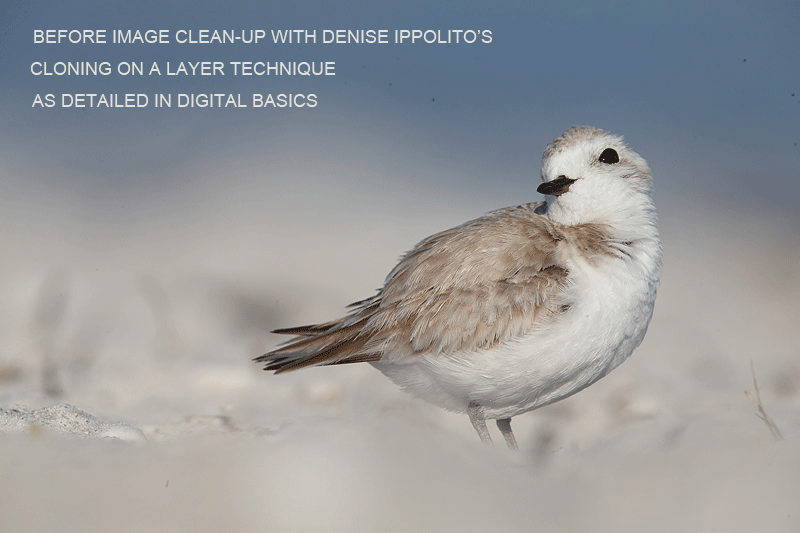
You can see a larger version of the optimized image in the “Baptism Under” Fire blog post here by clicking on the photo. |
Coy Snowy Plover Clean-up
You can see the original “Coy Snowy Plover” image in “Baptism Under” Fire by scrolling down post here. I put the entire image on its own layer, used the Clone Stamp Tool at 0 hardness and 100% Opacity, and cleaned up. By adding a regular layer mask and fine tuning the layer I did not need to make a single selection. As detailed in Digital Basics which includes my complete digital workflow, dozens of great Photoshop tips, Layer Masking for Dummies, all of my Keyboard Shortcuts, and tons more. Digital Basics, a PDF that is sent via e-mail, will be the best $25 you’ll ever spent on your photography. Your purchase includes free updates.
Snowy Plovers love to nestle down in areas with lots of beach debris and detritus. Their cryptic camouflage, more evident on the male birds, works best in such situations.
Photoshop Mystery Revealed
In the “Is It Real, or … ?” blog post here, everyone missed the boat, as did all the folks at BPN here. The reflection in the original image was untouched. Satish Ranadive of India did come up with a very creative repost that you can see by scrolling down to Pane #8.
In any case, see below for to learn what I did….
|
Sanderling flapping after bath. Created on Sanibel with the Canon EF 600mm f/4L IS II USM lens, the Canon 2x EF Extender III (Teleconverter), and the Canon EOS-1D X Digital SLR camera. ISO 800. Evaluative metering -1/3 stop: 1/1250 sec. at f/10 in Manual Mode. Lens foot buried in the sand. Central sensor (by necessity) Expand/AI Servo/Rear Focus AF active at the moment of exposure. Click here if you missed the Rear Focus Tutorial. Click on the image to see a larger version. |
The Optimized Image
The optimized image immediately above was actually created from two different frames from a rapid fire 1D X sequence. The speed of the 1D X is what separates it from the lightweight and fabulous for different reasons EOS-5D Mark III. Read on.
|
This image was created at 17:43:09. The image below was also created at 17:43:09, in the same one/one hundredth of a second. |
The First of Two
The image above, the first of the two frames, featured a perfect head angle and a lovely view of the far upper wing surface. But the near wing position was less than ideal with the wing not being fully raised.
|
This, the second of the two frames, was created at 17:43:09, in the same one/one hundredth of a second as the first of the two images. |
The Second of Two
With the near wing raised a bit more during this after-bath flap, the second image immediately above featured a much better view of the underside of the near wing with a really cool tail position and a great look at the tertials. But it had a lousy head position and not as good a view of the dorsal surface of the far wing.
Mystery Solved
The Photoshop solution was obvious to me and actually took only a few minutes. I painted a Quick Mask of the head and the far wing of the first image, placed it on a layer, brought it into the second image, positioned it by reducing the opacity of the layer, and then brought it back to 100% and fine tuned the edges while working at 100% as suggested by Denise Ippolito. That’s why none of our astute readers had a clue. Dust-spotting and image rotation was done after the head and wing graft was complete.
Additional details on all of the above can be found in Digital Basics which includes my complete digital workflow, dozens of great Photoshop tips, Layer Masking for Dummies, all of my Keyboard Shortcuts, and tons more. Digital Basics, a PDF that is sent via e-mail, will be the best $25 you’ll ever spent on your photography. Your purchase includes free updates. Would any of you like to see an MP4 video of this technique? If yes, let me know via e-mail.
Huge B&H Savings on Nikon and Canon Gear
Nikon
For the first time in many years NIKON is going to be deeply discounting many legacy pro lenses individually for the next 2 weeks only with discounts up to $350. There are also many amazing deals on NIKON Buy together and Save packages as well. Click here to save.
Nikon DSLRS Bundles with Lenses & Flash: Save up to $750. Click here to save. Make sure to add each item to your shopping cart to see the absolute lowest price.
Canon Lenses & Speedlites: Save Up to $300
Click here to save. Make sure to add each item to your shopping cart to see the absolute lowest price.
Canon Buy Together & Save: Save Up to $400
Click here to save.
EOS-1D X AF Guide
You can learn exactly how I set up and use this camera’s great new AF system in our EOS-1D X AF Guide. And you can learn about our camera User’s Guides here.
Southwest Florida Site Guide
Several folks have written recently asking why this great guide has not been updated since 2007. The answer is that I have not discovered any new hotspots and that the good places remain good and the great places remain great. We found the Snowy Plovers on Wednesday in the exact spot described in the Southwest Florida Site Guide. Go figure.
Africa Photo Safari: August 2013
Serengeti Summer Migration Safari: 12 full and two half-days of photography: $12,999/person double occupancy. Limit: 12/Openings: 9.
Leaders: Todd Gustafson, Denise Ippolito, and Arthur Morris. Tanzania Summer Migration Safari. Leave the US on August 3. Day 1 of the safari is August 5. We will visit Tarangire for great dry season photography, Seronera Lodge–aka Leopard City!–twice, Central Serengeti for big cats, Northern Serengeti and our mobile tented camp to search for river crossings, and the spectacular wildlife spectacle that is Ngorongoro Crater. Our last morning of photography is August 18. Fly home from Arusha, Tanzania on the evening of August 18.
A deposit of $4,000 is due now. This trip is a go. Happy Campers only please. Guaranteed maximum no more than 12 photographers plus the three great leaders. 3 persons/van. You get a row of seats for yourself and your gear. In addition to rotating in-the-field instruction with each of the co-leaders, artie, Todd, and denise will be available for image sharing and review and informal Photoshop instruction during breaks and after meals. And–with apologies to Miss Manners–even during meals!
Once we cash your check you will be strongly advised to purchase travel insurance. You may wish to consider using Travel Insurance Services. Do understand that most policies must be purchased within two weeks of our cashing your deposit check. The 2nd payment of $4000 is due MAR 30, 2013. The final payment/balance is due MAY 30, 2013. Sign up with a friend or a spouse and apply a $300 per person discount.
The lodging is all first class. Please e-mail to request a PDF with additional details, the complete itinerary, and a description of the unparalleled photographic opportunities that we will enjoy. Please e-mail or call me on my cell at 1-863-221-2372 with any questions. I hope that you can join us.
You can see a collection of my images from previous safaris here.
Weekend Creative Nature Photography Seminar, Tampa, FL: February 23 & 24, 2013: $149
You are invited to join Denise Ippolito and me on the weekend of February 23-24 on the outskirts of Tampa, FL for a great weekend of fun and learning. Learn to improve your photography skills, your skill at designing images in the field, your creative vision, and your image optimization skills. Sunday critiquing session. Click here for additional details and the complete schedule.
Fort DeSoto Morning In-the-Field Workshop/Two Slots Left!
Fort DeSoto In-the-field Workshop: FEB 25. Pre-dawn -10:30am. Strict Limit 16/2 Openings. Includes a great working lunch: $275.
On Monday morning, February 25, Denise Ippolito and I will be co-leading a morning In-the-field Workshop at Fort DeSoto, south of St. Petersburg, FL. We should get to photograph a variety of very tame herons, egrets, gulls, terns, and shorebirds. Spoonbills possible. There will be lots of individual and small group instruction. We will cover exposure and histograms, seeing the situation, creating sharp images, and lots more. Each registrant will have a personalized gear and set-up check. The more questions you ask, the more you will learn.
A great working lunch at the Sea Porch Café on St. Petersburg Beach is included. All are invited to bring a laptop along for image sharing at lunch. After the workshop, all are invited to send us three 1024 wide or 800 tall JPEGs for critiquing. Call 1-863-692-0906 to register or send us a Paypal. Either way, be sure to note that the payment is for the Fort DeSoto In-the-Field Workshop.
Typos
On all blog posts, feel free to e-mail or leave a comment regarding any typos, wrong words, misspellings, omissions, or grammatical errors. Just be right. 🙂
Support the BAA Blog. Support the BAA Bulletins: Shop B&H here!
We want and need to keep providing you with the latest free information, photography and Photoshop lessons, and all manner of related information. Show your appreciation by making your purchases immediately after clicking on any of our B&H or Amazon Affiliate links in this blog post. Remember, B&H ain’t just photography!
Support the BAA Blog. Support the BAA Bulletins: Shop Amazon here!
And from the BAA On-line Store:
LensCoats. I have a LensCoat on each of my big lenses to protect them from nicks and thus increase their re-sales value. All my big lens LensCoat stuff is in Hardwood Snow pattern.
LegCoat Tripod Leg Covers. I have four tripods active and each has a Hardwood Snow LegCoat on it to help prevent further damage to my tender shoulders :) And you will love them in mega-cold weather....
Gizo GT3532 LS CF Tripod. This one replaces the GT3530LS Tripod and will last you a lifetime. Learn more about this great tripod here.
Mongoose M3.6 Tripod Head. Right now this is the best tripod head around for use with lenses that weigh less than 9 pounds. For heavier lenses, check out the Wimberley V2 head.
Double Bubble Level. You will find one in my camera's hot shoe whenever I am not using flash.
The Lens Align Mark II. I use the Lens Align Mark II pretty much religiously to micro-adjust all of my gear an average of once a month and always before a major trip. Enjoy our free comprehensive tutorial here.
BreezeBrowser. I do not see how any digital photographer can exist without this program.
Delkin Flash Cards. I use and depend on Delkin compact Flash Cards and card readers most every day. Learn more about their great 700X and 1000X cards here or about my favorite Delkin card here.

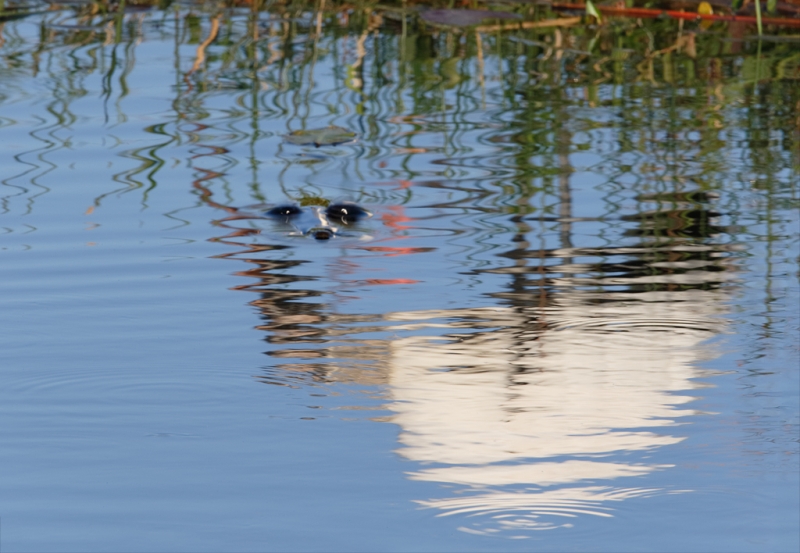
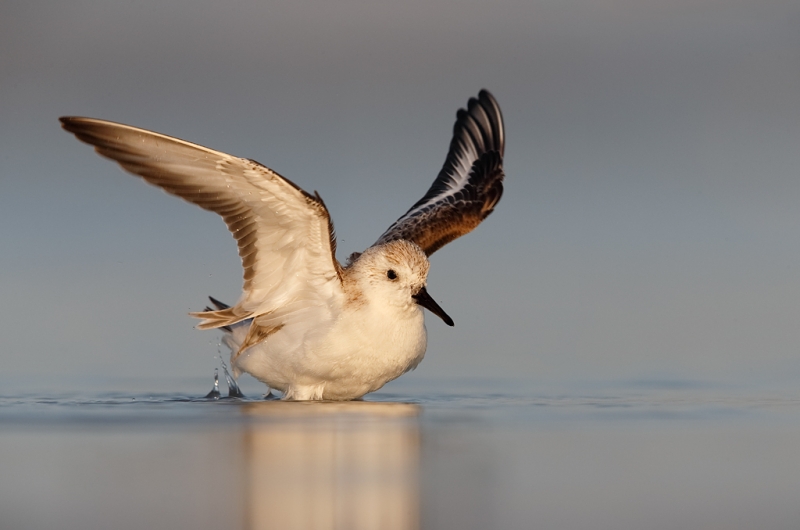
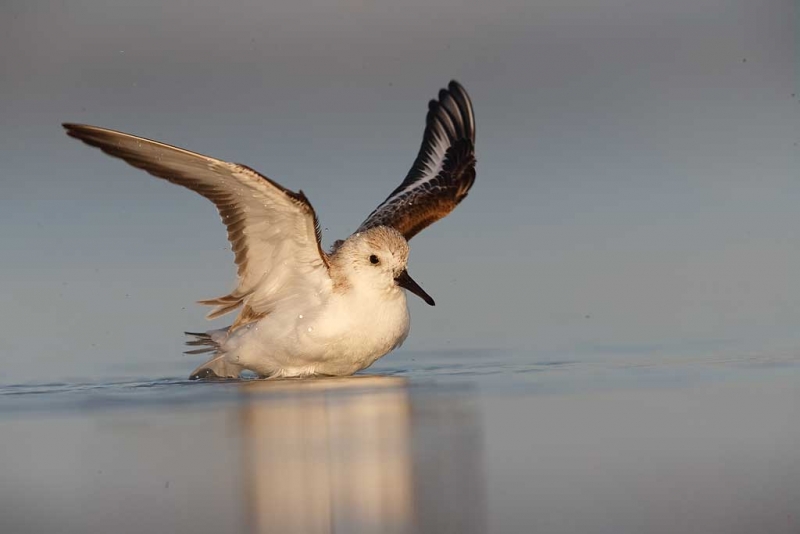
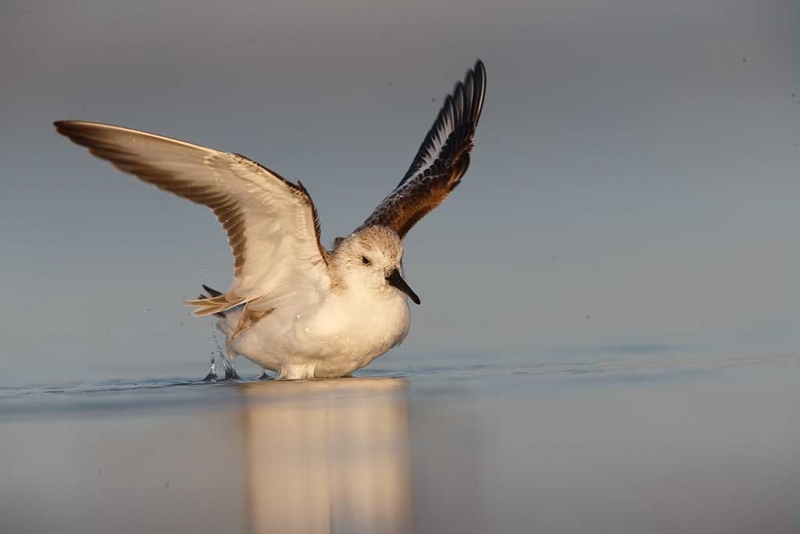
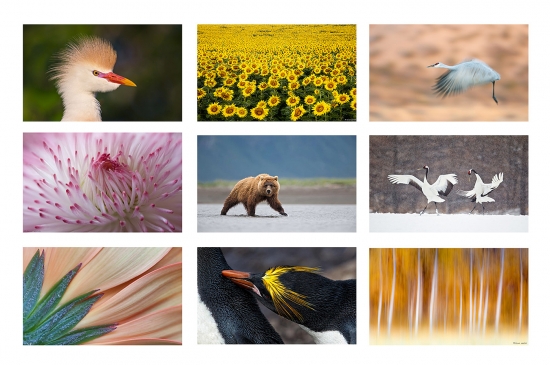













Artie,
I have caught many spiny softshell turtles in Florida visiting my grandparents growing up and I have seen them looking at my floating lures just like this photo. If I were going to bet, I would say that is exactly what you saw. They get quite large and can look like a small gator because their shells stay submerged most of the time. I have seen them as large as a garbage can lid sunning on the banks.
Here’s a link to see a good view of the shape of its head.
http://www.virginiaherpetologicalsociety.com/identification-keys/id-keys-turtles/turtle_id_page_7.htm
Thanks Bryan, But on scale, the animal on the surface is clearly a gator :).
I’m still a doubter on the critter being a gator. Their faces do not look like this at all. Sorry.
It is Interesting to compare the before and after images of both the snowy plover and sanderling and to learn the extent of processing that is performed to obtain the ‘perfect’ image. The extent of editing that one finds acceptable is, I know, a very subjective matter which I wish not to debate but only offer my opinion. As for capturing a moment in time, which I feel is the true essence of photography I would rate the first Sanderling photography far higher than the composite image. I find composite images such as this misleading as the moment portraid has never occurred or been seen, yet to the viewer without knowledge of the post processing the perfect moment has been captured.
In this situation however you have not mislead and I applaud you for that Art, as we are able to make our own informed opinions on the images.
A lot of us still not quite believing it is a ‘gator, but if you say so, we have to believe you! I thought it was a bear at first, then I realised there were unlikely to be any in that area!
Good luck in our BBC competition, I look forward to seeing their comments.
I love your image of the stork reflection and critter from the Anhinga Trail. At first I too thought the critter might be a gator. But something about the eyes and nose botheres me about that. The eyes face forward. A gator, like other reptiles, has side mounted eyes that work independently. Also, a gator’s nose is quite bulbous and rounded. And the snout between the eyes and nose is concave with a pronounced downward curve. This critter has forward facing eyes, typical of a carnioverous mammal, a fairly small nose that is more oval (like a dog or weasel), and the snout between the eyes and nose appears straight. I don’t know what this critter is, but the image is great.
Thanks Dane. With the gator swimming toward me and the slow shutter speed there is considerable distortion. Heck, I never saw any animal when I was photographing and thought that it was a raccoon when I first saw it…. Other told me that a gator swam through the reflection….
What happened to “there is no bird”??????
There is no bird. Just the reflection of a bird. See Melissa’s comment and my reply.